Today’s Fixed-it Friday post is a little different…I’m updating a past Decoded article to share an important “fix” that has been approved for the 2027 edition of the I-Codes. As interlocks (AKA man-traps or control vestibules) have become more common in labs, health care facilities, data centers, and other high security locations, the fact that they were not specifically addressed in the model codes has become more problematic. I’m happy to say that this application will be addressed in the next edition of the IBC and IFC.
~~~
This Decoded article was published in Door Security + Safety
.


The purpose of a control vestibule is to limit immediate through passage into or out of an area, to reduce air transfer or increase security.
In some buildings, limiting the flow of pedestrian traffic is a method used to reduce air transfer or to provide increased security. Examples of these locations include clean rooms in laboratories, infection control areas in health care facilities, data centers where secure information is stored, and cash counting rooms in casinos or banks. Control vestibules are sometimes incorporated into the design to limit immediate through passage into or out of these areas.
A control vestibule is a space with two or more doors in series, arranged so that when one door is open the other door or doors cannot be opened. Under normal operation, a building occupant opens one door to enter the vestibule, and that action causes the other door(s) to lock until the first door closes. The building occupant may then open another door to exit the vestibule. This function is facilitated by electrified hardware – often electromagnetic locks that are controlled by door position switches. Control vestibules are commonly called interlocks, mantraps, or air locks.
Although the physical layout is similar, a control vestibule should not be confused with a sallyport – this is a term that is typically used in detention and correctional settings. A sallyport is defined by the International Building Code (IBC) as: A security vestibule with two or more doors or gates where the intended purpose is to prevent continuous and unobstructed passage by allowing the release of only one door or gate at a time. The IBC allows sallyports to be used in I-3 occupancies (ex. correctional centers, jails, prisons), if there are provisions for egress during an emergency condition. Sallyports in a detention setting are different from the control vestibules used in other occupancies, because a sallyport typically prevents user passage under normal operation and a control vestibule allows user passage through one door at a time.
The model codes do not currently include prescriptive requirements for control vestibules in use groups other than I-3 – each proposed system must be submitted to the Authority Having Jurisdiction (AHJ) for approval. Without guidance in the codes to mandate safety overrides and release methods, requirements can vary from one AHJ to the next, or even between projects in the same jurisdiction. Because of the potential for interlocks to inhibit egress, the operation of these doors during an emergency is critical.
A change addressing control vestibules has been approved for the 2027 edition of the I-Codes, and a proposal is in the works for the 2027 edition of NFPA 101 – Life Safety Code. Until these editions are adopted in a given jurisdiction, it will be up to the AHJ to decide how to evaluate a proposed control vestibule. However, the approved section provides some good guidance for these applications.
For the 2027 I-Codes, proposal E61-24 addresses the following requirements:
- Definition: The I-Codes will define a control vestibule as: A space with doors in series that are interlocked such that when one door is open other doors are restricted from opening.
- Use group or occupancy classification, and occupant load: It is typically easier to ensure the safety of building occupants using a control vestibule in a “trained-traffic” situation, where people are familiar with the operation of the system. For this reason, the 2027 I-Codes will permit control vestibules in the means of egress for security, environmental control, or clinical needs in:
- Groups F, H-3, H-4, H-5, I-1, I-2, and S where the occupant load of the room or space served by the control vestibule is less than 50.
- Groups B and M where the occupant load of the room or space served by the control vestibule is 10 or less.
- Fire suppression/detection systems: The new section will require the building to either be equipped throughout with an automatic sprinkler system, or for the room or space served by the control vestibule to have an approved automatic smoke detection system. Activation of these systems must deactivate the interlock function of the control vestibule doors, to facilitate immediate egress through the vestibule. This requirement also applies to areas that have an emergency alarm system for hazardous materials.
- Door operation: Doors in control vestibules must swing in the direction of egress travel (exception: power-operated doors in accordance with Section 1010.3.2), and must be equipped with self-closing devices.
- Power failure: As with other special locking arrangements, loss of power must result in the deactivation of the interlock function of the doors in the control vestibule, to allow free egress. Fail safe locks will operate as required by code, as they unlock upon loss of power.
- Egress-side override: If one door in a control vestibule fails to close, it will prevent the operation of the other doors. To address this potential barrier to egress, an override switch is required on the egress side of each door. Operation of the switch must result in direction interruption of power to the electrified locks – independent of the other electronics, and the locks must remain unlocked for at least 30 seconds. An audible alarm could be incorporated to deter use of the override switch in non-emergency conditions, although this is not crucial for life safety. The code addresses the required location of these switches.
- Signage: Signage is required with instructions on the use of the interlock override switches, to ensure that building occupants understand how the control vestibule operates under emergency conditions.
- Number of control vestibules: To minimize the effect on egress, the I-Codes will state that the egress path from any point shall not pass through more than one control vestibule.
- UL listings: The model codes require some types of electrified hardware to be listed to UL 294 – Standard for Access Control System Units or to UL 1034 – Standard for Safety for Burglary-Resistant Electric Locking Mechanisms. This is typically required when the hardware could affect egress, and this listing will be required for electrified locks used in a control vestibule.
Remember, these considerations are not currently included in the model codes but should be addressed when designing a control vestibule that will be submitted to the AHJ for approval. In some jurisdictions, there may be local code modifications related to this application; it’s also possible that a jurisdiction may prohibit control vestibules completely. Including the new requirements in the 2027 model codes will help to ensure a more consistent approach to these special locking arrangements.
You need to login or register to bookmark/favorite this content.


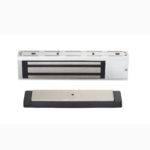
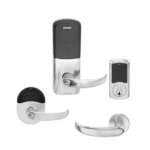
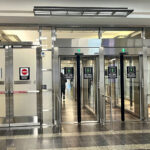


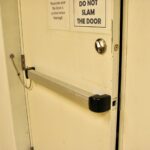
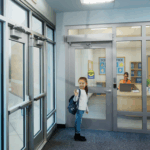
Good revision
50 seems low for F,I, and S. And high for H 3 and 4
No problem with H-5
How come did not include/ match button requirements as for magnetic locks? Or code reference to them.
And no required pull station at vestibules, to open the doors?
Anyway
This seems like a mostly reasonable proposal from the description here, although I break it down into several cases:
1. Trained-traffic only (except for the occasional tour group, contractor, or the likes). This is the situation in F, H-3 thru H-5, and non-self-service S occupancies, and the amendments seem reasonable to me in these cases.
2. Closely supervised traffic. This is the situation in I-1 and I-2 occupancies, where the hazards posed by visitor use of control vestibules are mitigated by the 24/7 watchful eye of staff trained and drilled in pre-planned emergency actions. This, again, renders the proposal reasonable for the situation, especially considering the requirements for, and widespread deployment of, sprinkler protection in institutional environments.
3. Public traffic. This is the most difficult situation, and is raised in B occupancies (like the biosecurity control vestibule in the butterfly vivarium discussed in the proposal’s rationale) as well as the permission the proposal grants to use control vestibules in M and public (parking, self-service) S occupancies. The rest of this post will discuss the situation here, as it’s probably the most critical case for life-safety as a matter of public exposure, and also is where the current proposal falls short in a few key aspects.
First off, if there’s any case where the proposal should prohibit control vestibules but doesn’t, it consists of parking and self-service S occupancies. These occupancies, unlike _all other storage occupancies_, are largely occupied by the general public instead of being occupied by trained personnel. Furthermore, they are often used by the public in a casual or occasional fashion that does not grant users a great degree of familiarity with the building, unlike a warehouse employee who works in the same building day-in and day-out, and may be operated without any attendants on-site.
We then move to the other public-access situation, which consists of the use of control vestibules in public parts of B and M occupancies. Control vestibules here have their uses, such as in securing high-value merchandise or protecting the wild world from invasive hitchhikers, but require a greater degree of care and supervision than is normally present in a B or M occupancy. Requiring that a trained member of staff be present at the control vestibule and responsible for occupant safety whenever the controlled space is open to the public makes sense here, I reckon, in addition to the occupancy limitations these amendments place on the space controlled by the vestibule. This way, if an emergency (which need not be a fire!) does develop, there will be someone present who can summon aid and operate the vestibule, instead of leaving a public user of the vestibule to fend for themselves.
Finally, we get to non-public spaces in B and M occupancies, which fall back into the trained-traffic-only “easy case”, or at most a supervised-traffic situation, where public users of the vestibule will only be doing so while accompanied by staff. While the occupancy limit of 10 people in the controlled space may seem onerous in this situation, it could be adjusted for non-public B spaces as the amendments are refined, and also may serve as a crude way of limiting the size and scope of controlled spaces, although some largely-unmanned, highly-secured spaces, such as data centers, do pose challenges to this paradigm.
Thanks for sharing your insight!
– Lori
What about the requirement for panic hardware for “H’s” ???
Good question. I guess the doors could still have panic hardware along with the electromagnetic locks controlling the interlock function. What do you think, Charles?
– Lori